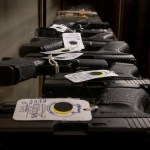At The 19th, we’re committed to publishing journalism that you can trust throughout the critical moments that shape our democracy and our lives. Show your support during our Fall Member Drive, and your donation will be matched. Double your gift today.
Thirty years ago today, President Bill Clinton signed the Brady Handgun Violence Prevention Act into law, creating a system of federally mandated background checks on firearm purchasers. The law, known colloquially as the Brady Bill, also implemented a five-day waiting period on firearm purchases — something that held until the National Instant Background Check System (NICS) was created five years later, in 1998.
The Brady Bill was a first-of-its kind piece of legislation, one of the biggest swings at the time at thinking about gun safety from a federal level and what it means to prevent individuals with significant criminal records from being able to freely access firearms. The law is named for James Brady, who was President Ronald Reagan’s press secretary when John Hinckley Jr. made his assassination attempt on Reagan in 1980. Brady was shot in the head during this attempt, leaving him partially paralyzed for life. Hinckley had been arrested four days prior to purchasing the gun used in that attack, was under psychiatric care prior to making the purchase, and had committed a felony in purchasing the firearm by giving a fake address and showing an old driver’s license in his application to purchase it. Sarah Brady, James Brady’s wife, became a gun safety advocate following the shooting — and felt strongly that a background check could have likely prevented the gun sale from having ever taken place to begin with.
On January 8, 2011, Congresswoman Gabrielle Giffords survived an assassination attempt and mass shooting during a constituent event being held in a grocery store parking lot in suburban Tucson, Arizona, that left six people dead and 12 others injured. Like Brady, she was also shot in the head. After her recovery, Giffords resigned from Congress and started GIFFORDS, an anti-gun-violence advocacy organization that seeks to challenge the role of the gun lobby in American politics.
On the occasion of the 30th anniversary of the Brady Bill, Giffords spoke with The 19th about the progress made since its enactment, the current impact of gun violence on American culture and politics, and what it will continue to mean for the federal government to address gun safety in America.
This interview has been edited for length and clarity.
Jennifer Gerson: How would you describe the current cultural moment when it comes to gun safety culture in America? How is this cultural moment in line with or different from what you perceive to be the current political moment when it comes to gun safety?
Gabrielle Giffords: Culturally, Americans want action. Politically, our leaders are behind and need to govern from a place that reflects that. We saw some movement with the passage of the Bipartisan Safer Communities Act last year, when 15 Republican senators voted in favor of the bill. However, much more needs to be done — both in states and at the federal level — to meet the moment.
Americans from all backgrounds are sick and tired of gun violence. They don’t want to worry about their kids being shot at school or while playing in their neighborhoods. Poll after poll shows that the majority of Americans, across party lines, want common-sense gun safety solutions like universal background checks and extreme risk protection orders.
When you think about the 30 years since the signing of the Brady Bill, what surprises you the most about where we are today? What do you see as the biggest wins of the past 30 years? The biggest delays or losses?
The state of gun safety in the United States is completely different than it was 30 years ago when the Brady Bill was signed into law. After the Brady Bill, the [National Rifle Association (NRA)] and gun lobby built an enormous amount of power and political influence. Up until the Sandy Hook shooting [in 2012], politicians of both parties listened to the gun lobby and avoided the topic of gun safety as much as possible. But today, there’s not a single Democrat in Congress who has an A from the NRA, and many Republicans welcome gun safety groups into their offices. The persistence of the gun safety movement is the reason we were able to pass the Bipartisan Safer Communities Act in 2022, the first major federal gun safety bill enacted since the Brady Bill.
Despite these gains, we’ve seen gun violence and mass shootings rise over the past few decades, leading to an enormous loss of life each year. The extremism flaunted by the gun lobby has further polarized Americans, making it harder to enact common-sense gun safety measures. While states like California, Michigan, Minnesota, Connecticut, and more have acted to address gun safety, others like Florida and Texas have actively weakened their gun laws, putting their residents at higher risk for gun violence.
From where you sit, what do you think the most pressing issues are when it comes to gun safety? What legislative measures do you think would be most impactful?
Passing common-sense policies like universal background checks and extreme risk protection orders would make an enormous difference in the fight for gun safety. Extreme risk protection orders, also known as “red flag” laws, allow family members, friends and law enforcement to proactively suspend a person’s access to firearms if they exhibit warning signs of violence — helping prevent mass shootings and other tragedies. These policies are supported by the majority of Americans and are proven to save lives. Studies have found that Indiana and Connecticut’s extreme risk protection laws have reduced firearm suicides and saved lives in both states.
For too long, the gun industry has been given special treatment by the courts. Because of a law enacted in 2005, gun manufacturers and sellers have been immune from lawsuits due to an unfair and unjust law that protects them from the normal rules of civil litigation. Congress should repeal that law. Ensuring the gun industry is treated like any other industry is key to protecting our communities from gun violence.
How do you think about the work of the states versus the work of the federal government when it comes to gun safety work? What do you think leadership and imagination around the gun violence epidemic in America can and should look like now?
I always say that when it comes to progress in gun safety work, it is going to happen inch by inch. That’s how we’ve approached our state and federal work. We passed the first federal gun safety law in nearly 30 years last year, and in states across the country we’ve passed more than 500 gun safety bills since the Sandy Hook Elementary School shooting.
Given the works GIFFORDS has done for so many years now, what do you think is most important for people to understand about who is impacted by gun violence and how that is felt in communities? What stories and realities need the most attention today?
People need to understand that when the news cycles move on, communities and survivors do not. It’s been nearly 13 years since I was shot, and I still think of those who lost their lives that day every single day, as do their families and friends. It’s not just the people who were shot who are affected by gun violence, it’s all the survivors: those who lost loved ones, those who care for people injured by gun violence and those who experience the trauma of a shooting. Nobody should have to feel the pain of gun violence, but too many communities have. GIFFORDS remains committed to continuing to support them and lift up their stories.






